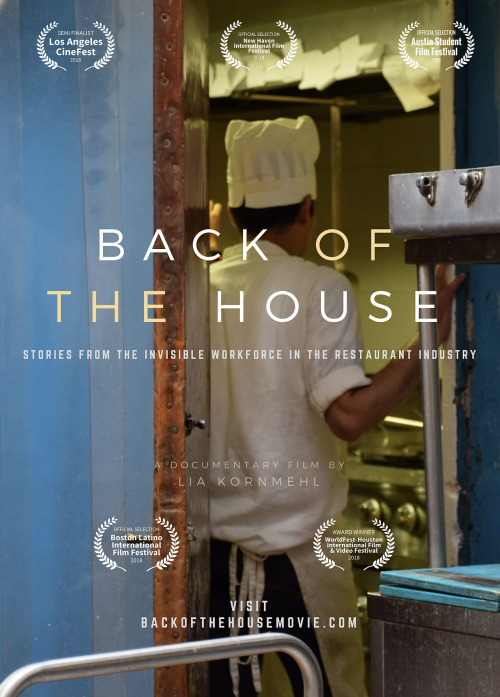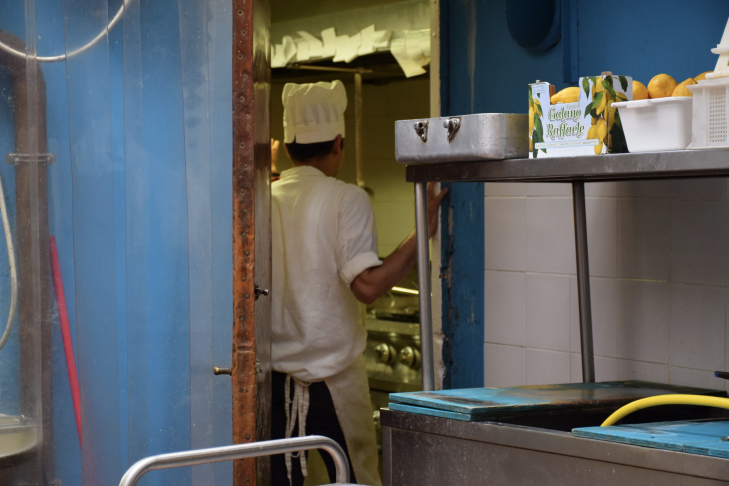According to the National Restaurant Association, restaurants in the United States employ a significant number of foreign-born workers. More than 23 percent of individuals working in restaurants are foreign-born, versus the 19 percent who are counted in the overall economy. The Association further reports that 45 percent of chefs are foreign born, as are 24 percent of restaurant managers. And immigrants are more likely to own a restaurant than any other business.
Those numbers, as well as the plight of Latino immigrants, impressed Lia Kornmehl, a senior at The Winsor School in Boston. Kornmehl has made a 22-minute documentary about immigrant restaurant workers called “Back of the House.” The title is industry jargon for the kitchen, where an invisible workforce prepares and cooks food in many of America’s restaurants. In the film, Kornmehl cites further statistics that 71 percent of Latino immigrants are from Central America and Mexico, and 33 percent of Latino residents are undocumented.
Kornmehl recently spoke to JewishBoston about her documentary, which will be shown at the Boston Latino International Film Festival on Friday, Sept. 28, at Harvard University. Kornmehl will be on hand to participate in a Q&A after the film.
What inspired you to make a documentary about immigrants in the restaurant industry?
In 2016 I studied U.S. history and learned about American immigration policies from the 1800s to the 1950s. In class, we compared the rhetoric of those times to the way immigrants, particularly Latin American immigrants, are demonized today. I realized nothing had really changed. My paternal grandparents are both immigrants. Following World War II, they immigrated from Germany and Poland, and their life here was a classic tale of working really hard and giving their children the opportunity to succeed in American society.
Upon self-reflection, I understood that I had a lot of privilege—I have an amazing education and a wonderful, supportive family—and I wanted to give the people who didn’t have that a voice. To do that I needed to educate myself, as well as others, that there is a different side to our collective idea of who an immigrant is. Individual people who are not represented needed to be highlighted. I wanted to hear their individual stories and their motivations for coming to the United States.

What led you to focus on the restaurant industry to tell the story of Latino immigration?
I focused on the restaurant industry because there are so many immigrants—documented and undocumented—who are working in hospitality. I wanted to highlight them, as well as bring attention to who is doing the prep work, the line cooking—all the behind-the-scenes work—of the fancy restaurants we go to. In the jargon of the industry, they work in “the back of the house.” Who is coming in very early and who is leaving very late? We’re not seeing those people. They are an invisible workforce.
How did you get access to this invisible workforce?
It was difficult to get in touch with people because of the nature of their work and their immigration status. I called over 100 restaurants over the course of the project. For every 25 restaurants I called, I would get one “maybe,” and that only worked out half of the time. I had to make many phone calls to end up with three restaurants and a labor union that would go on the record.
I also realized I wasn’t going to get anywhere by calling restaurants where the immigrants were exclusively in the back of the house. I had to call immigrant-owned restaurants. That led me to Sangria in Newton. The owner, Nora, is in the film. She was skeptical at first, but she came to appreciate that making the documentary was an important learning experience for all of us. From there I interviewed another restaurant owner from Guatemala. I encountered people who did not want to be on camera, which is why in the film, some of my interviews do not show the interviewees’ faces.
A woman named Alba is at the center of the film. How did you meet her?
I met Alba through Brian Lang, the president of Boston Local 26—the union for hospitality workers. I interviewed him, as well as two other people who were experts in the field of immigration. I brought in the dean of Boston College Law School, as well as a prominent immigration lawyer, to give the documentary context. Initially, I had a vision of just including immigrant perspectives, but that changed.
Alba is an organizer in the Local 26. I brought my camera and tripod and took three trains to see her in Medford. We did two long interviews. It was quite an experience for me. There was a large contingent of people from Latin America, and everyone in the office spoke Spanish. It was so gratifying to hear Alba’s perspective alongside Brian Lang’s.
How long did it take you to make the film?
I worked on the film from January 2017 to November 2017, and I made it independently of school. Along the way, I educated myself to ask the best questions I could in these interviews. I wanted to interview the immigrants—the majority of whom spoke Spanish—in their language. I had to do some translating, and for that my Spanish teacher was a big help. As I was filming, I was aware that there is a lack of first-person perspectives in Spanish. Asking them to speak exclusively in English would have simplified their story.



